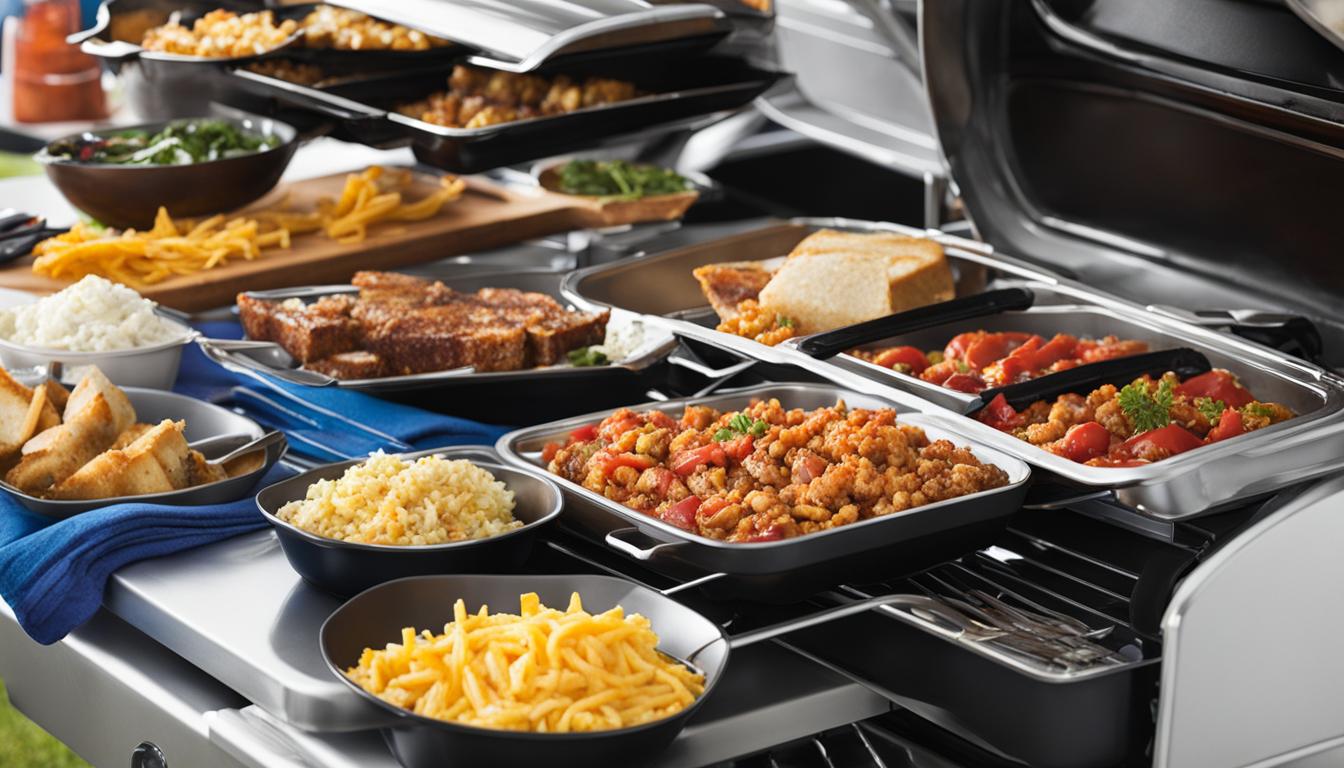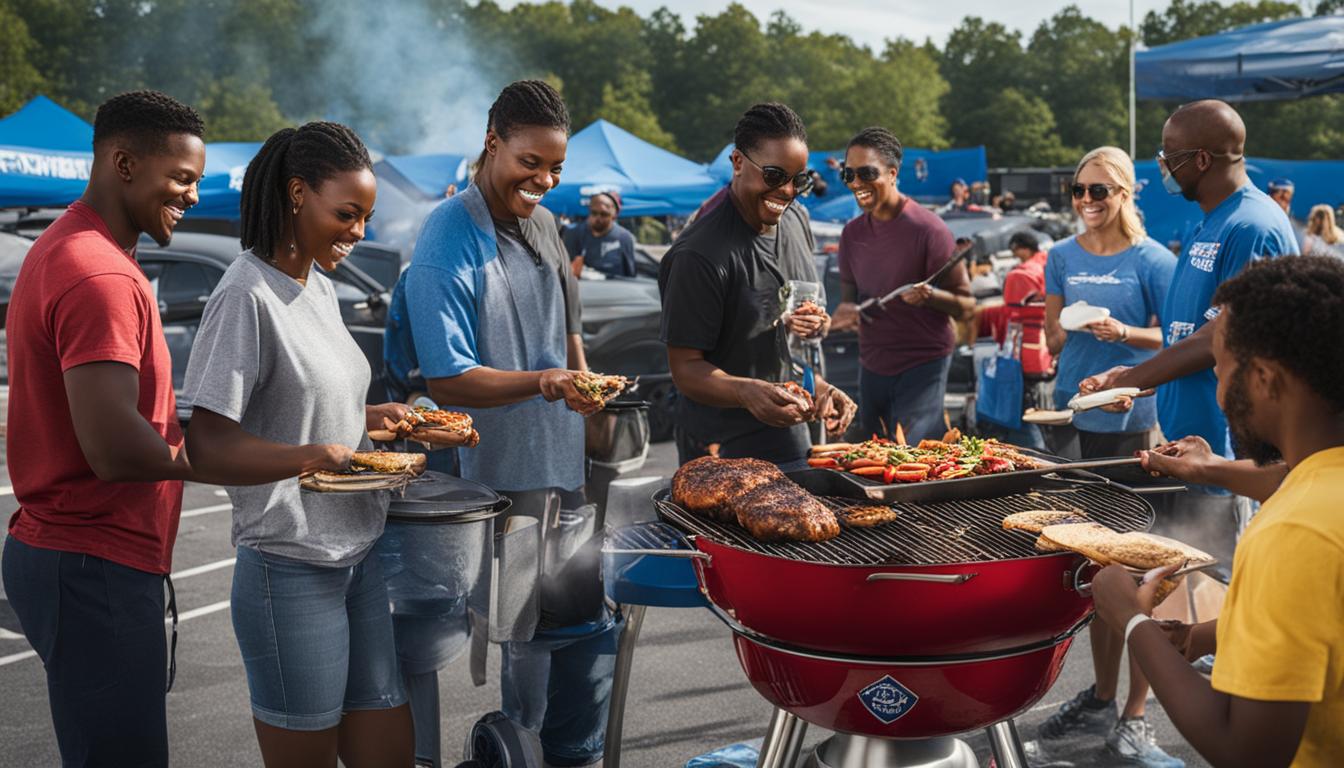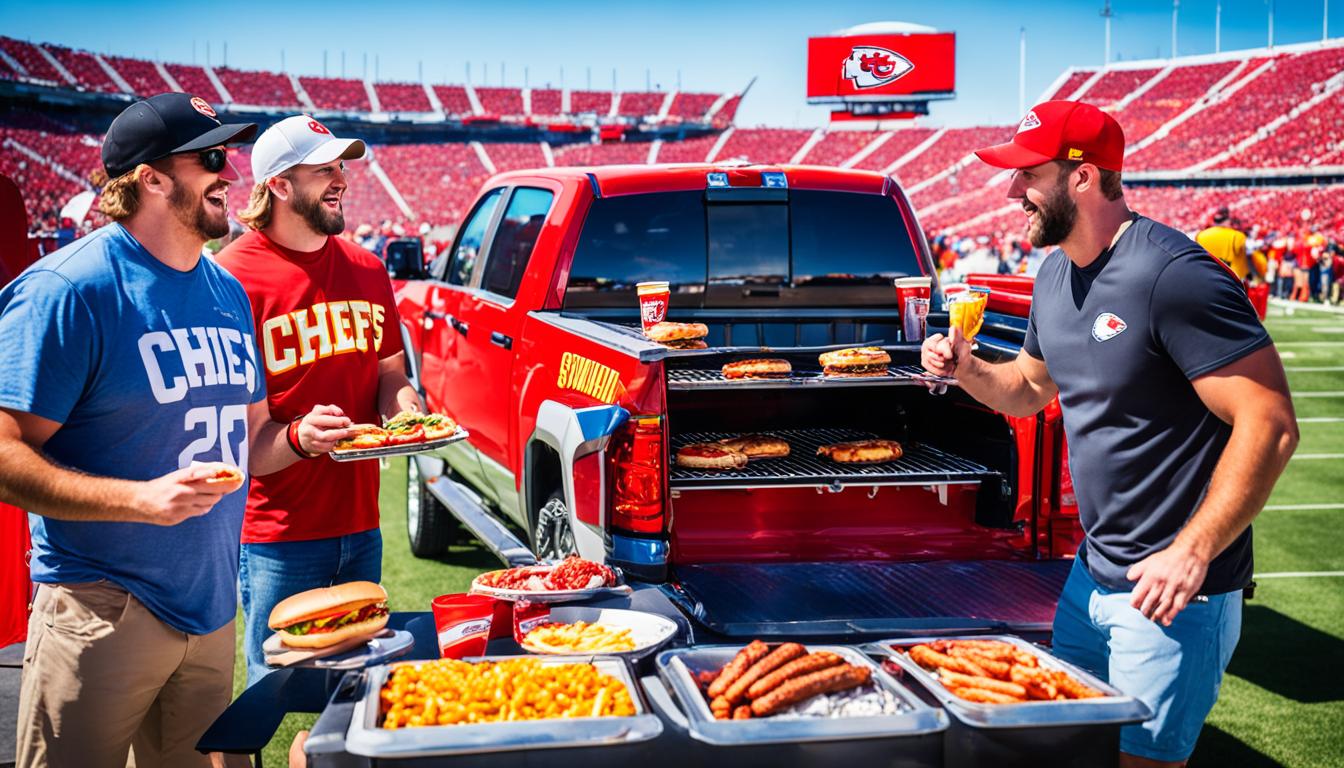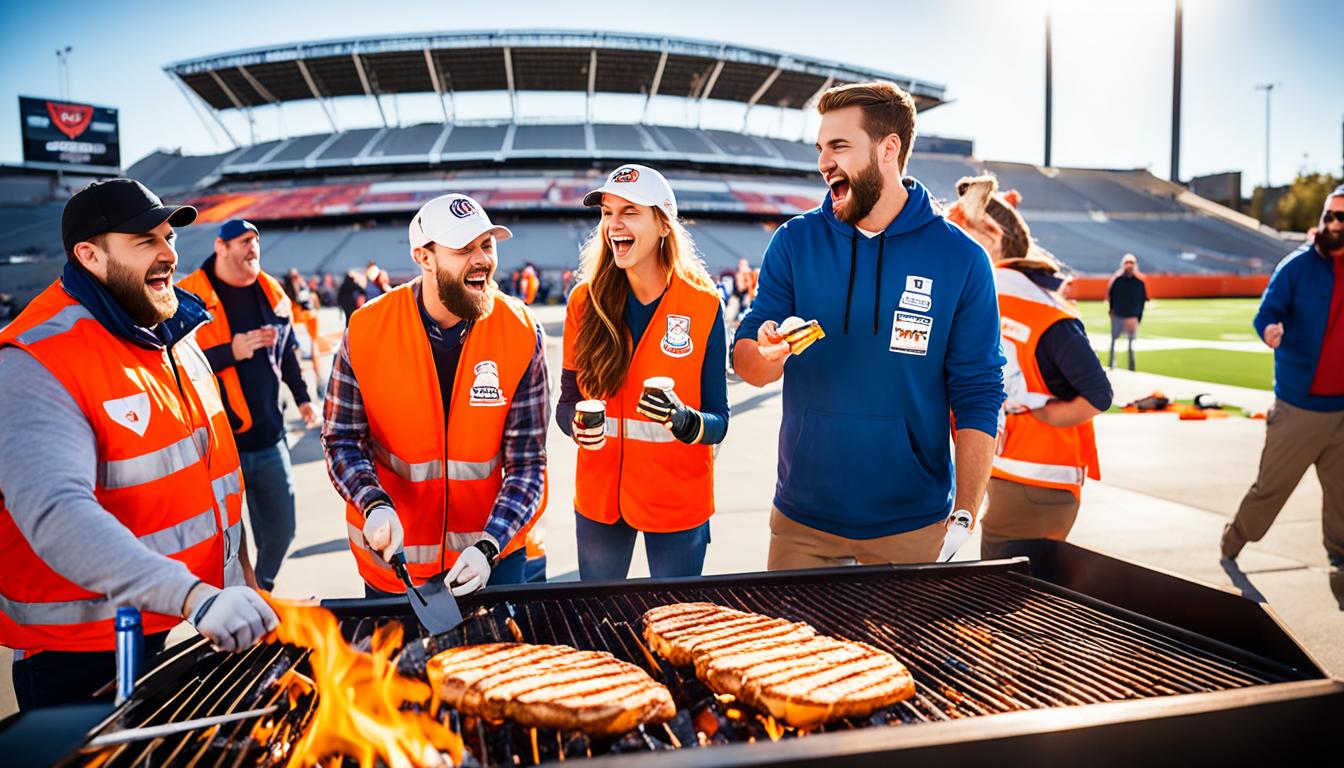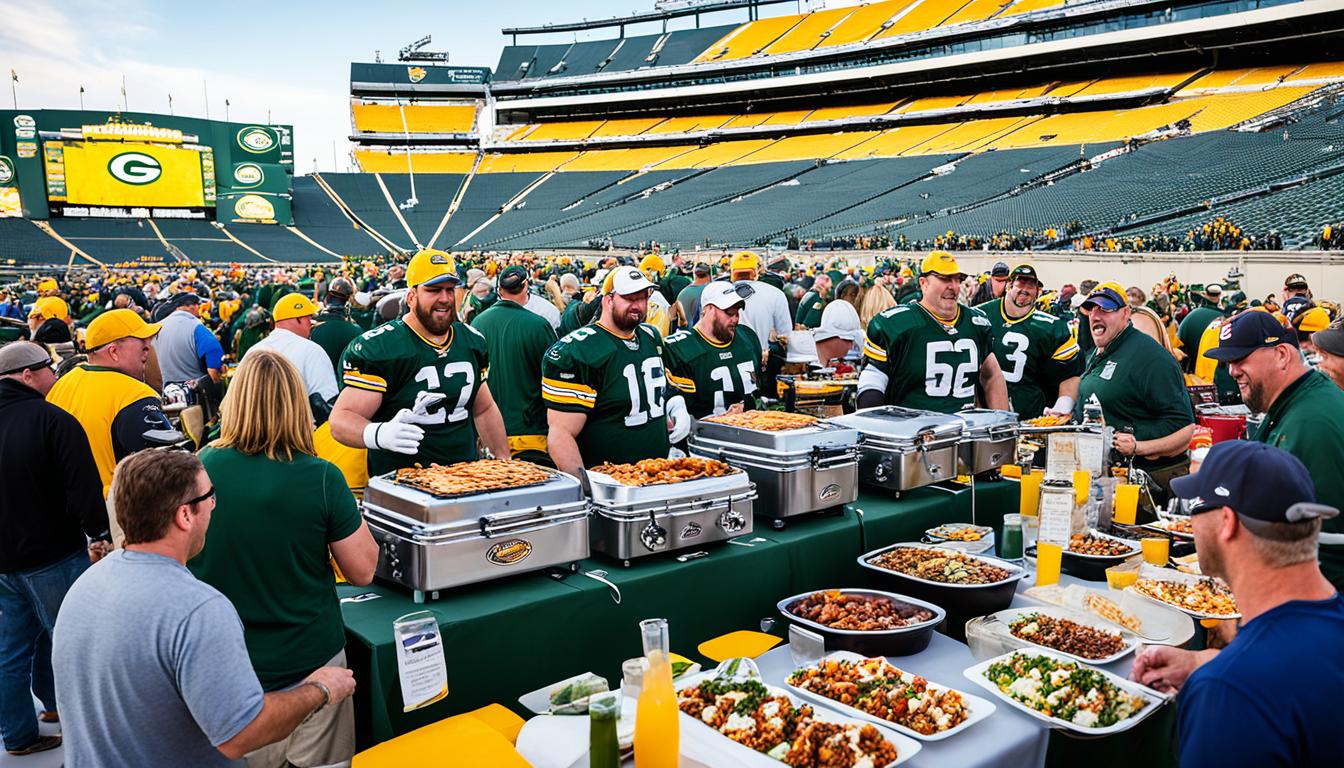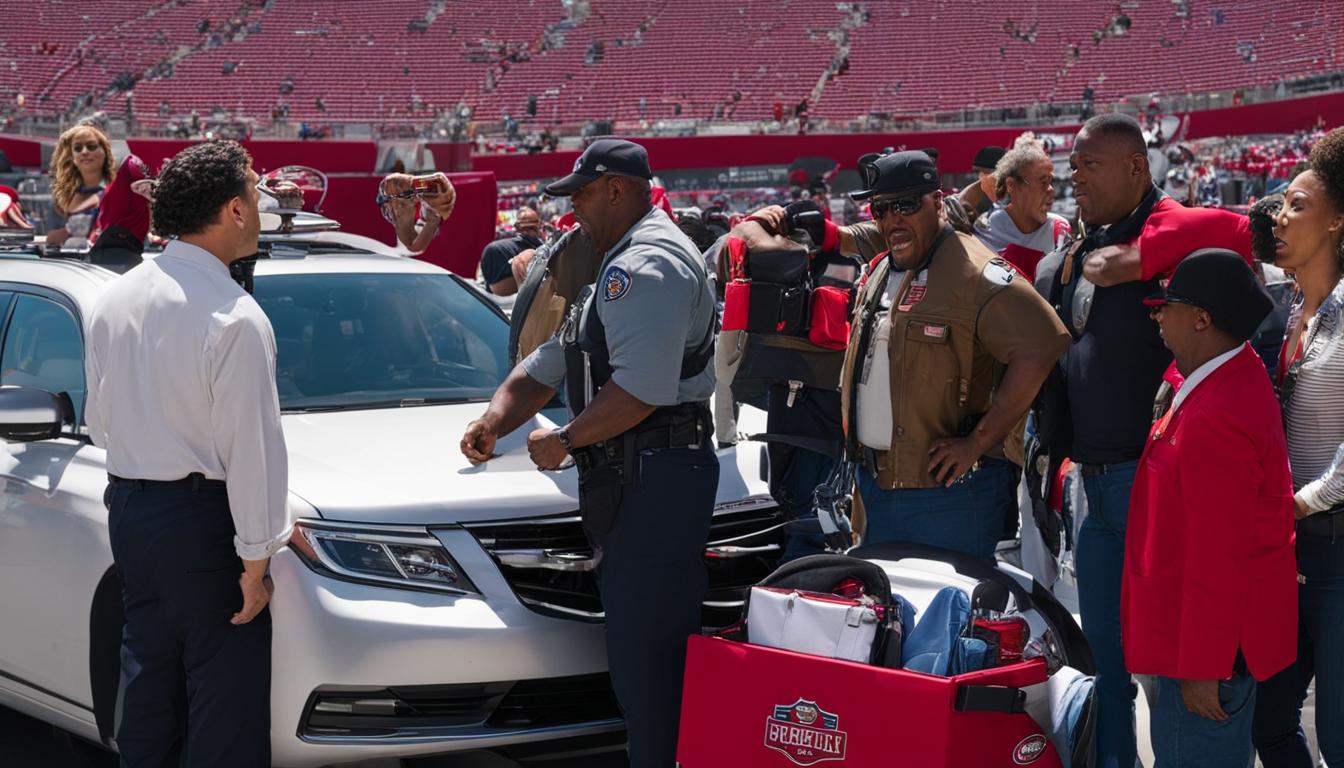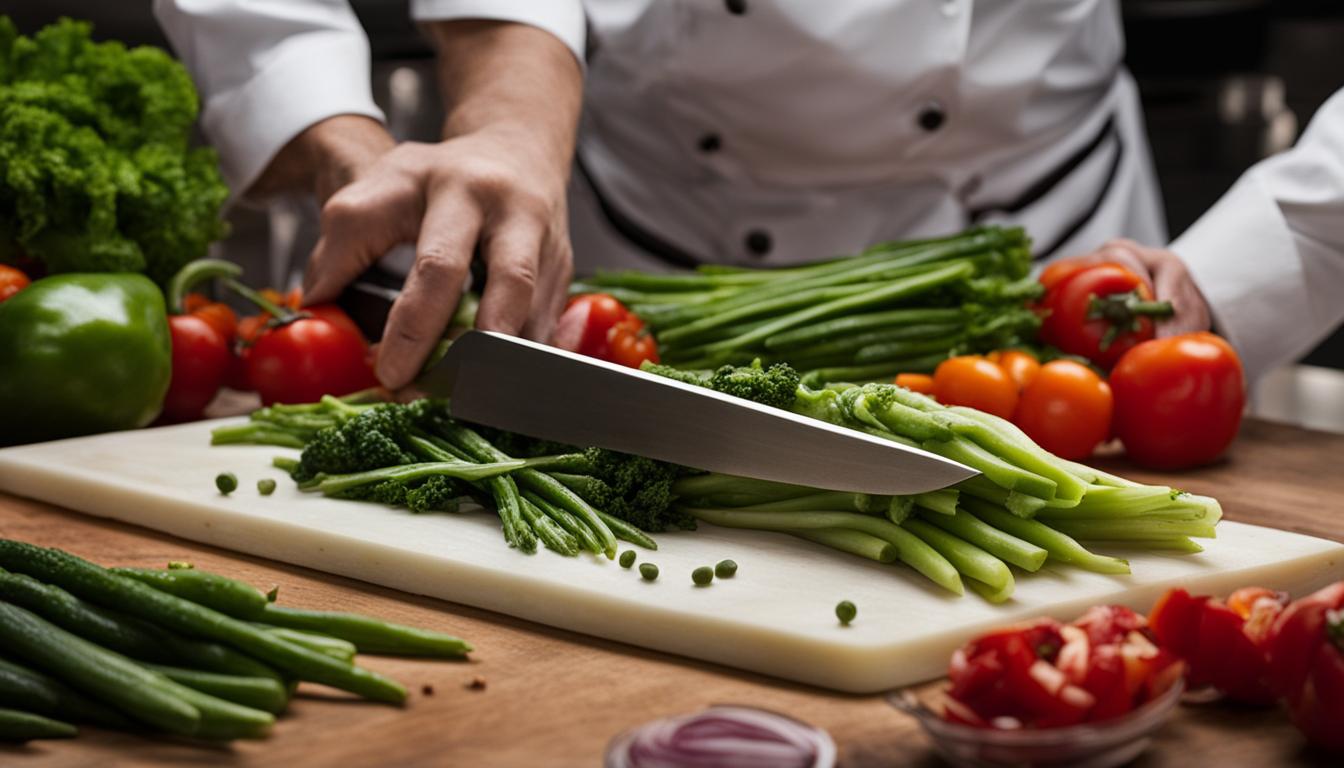
When it comes to tailgating, food is an essential part of the experience. However, it’s important to prioritize food handling safety to ensure that your tailgate event is not only a hit but also safe for everyone involved. By following proper food safety practices and guidelines, you can prevent foodborne illnesses and create an enjoyable and hygienic environment for all.
Proper food handling involves a variety of practices, including safe food storage, hygiene, and temperature control. By paying attention to these critical aspects, you can significantly reduce the risk of foodborne illnesses. Whether you’re a seasoned tailgater or new to the game, it’s never too late to brush up on your food safety knowledge.
Key Takeaways:
- Always practice safe food handling to prevent foodborne illnesses.
- Follow proper food hygiene practices, including regular handwashing.
- Keep cold foods cold and hot foods hot to maintain their safety.
- Use a calibrated food thermometer to ensure meats are cooked to the proper internal temperature.
- Clean and sanitize cooking utensils and surfaces to prevent cross-contamination.
Importance of Food Safety at Tailgating
Tailgating has evolved over the years, becoming more elaborate with the setup of outdoor kitchens and a wide variety of dishes. While it’s an exciting and enjoyable tradition for football fans, it’s crucial to prioritize food safety practices to prevent foodborne illnesses.
Food safety practices play a vital role in ensuring that the food served at tailgate events is safe and free from harmful bacteria that can cause illnesses. Without proper food handling and preparation, tailgaters can unknowingly put themselves and their guests at risk.
Implementing food safety guidelines during tailgating is essential for several reasons. First and foremost, it helps prevent the spread of foodborne illnesses, safeguarding the health of everyone in attendance. Additionally, practicing good food safety habits enhances the overall dining experience, ensuring that the food tastes delicious and is enjoyed without any worries.
Protecting Against Foodborne Illnesses
Foodborne illnesses, caused by consuming contaminated food or beverages, can lead to unpleasant symptoms such as nausea, vomiting, diarrhea, and stomach cramps. In more severe cases, they can even result in hospitalization. By following proper food safety practices, you can significantly reduce the risk of foodborne illnesses at your tailgate event and protect the health of your friends, family, and fellow fans.
One of the critical aspects of food safety during tailgating is ensuring that food is properly cooked. Adequate cooking temperatures kill harmful bacteria, ensuring that the food is safe to eat. Using a food thermometer is highly recommended to achieve and maintain the proper internal temperatures of various meats and dishes.
The Importance of Proper Food Handling
In addition to cooking temperatures, proper food handling is essential to prevent cross-contamination and the spread of bacteria. This includes washing hands thoroughly before and after handling food, using separate cutting boards for raw and cooked items, and storing raw meats properly to prevent their juices from contaminating ready-to-eat foods.
Food Storage and Transportation
During tailgating, it’s crucial to maintain the proper storage and transportation of food to prevent bacterial growth. Cold foods, like salads, should be kept chilled with ice packs or in a well-insulated cooler to keep them below 40°F. On the other hand, hot foods should be kept above 140°F to maintain their safe temperature. Investing in a reliable cooler and using temperature-monitoring devices such as food thermometers are highly recommended.
By following these food safety practices before, during, and after your tailgate event, you can ensure that everyone enjoys the delicious food without any concerns about foodborne illnesses. Prioritizing food safety is a crucial part of hosting a successful and memorable tailgate gathering.
Keeping it Clean: Handwashing and Hygiene
Unclean hands are a major cause of foodborne illnesses. To prevent the spread of bacteria, it’s essential to prioritize handwashing and maintain proper hygiene practices while handling food. By following these food safety practices, you can significantly reduce the risk of foodborne illnesses.
Handwashing:
One of the most important steps in food safety is proper handwashing. Wash your hands with soap and warm water for at least 20 seconds before and after handling food. This helps remove any harmful bacteria that may be present on your hands.
Proper handwashing technique:
- Wet your hands with clean, running water.
- Apply soap and lather well, covering all surfaces of your hands.
- Rub your hands together vigorously for at least 20 seconds.
- Make sure to scrub the backs of your hands, between your fingers, and under your nails.
- Rinse your hands thoroughly under clean, running water.
- Dry your hands using a clean towel or air dry them.
Handwashing supplies:
When tailgating, it’s important to have the necessary supplies for handwashing. Make sure to bring clean water, liquid hand soap, and paper towels for hand drying. This ensures that you can maintain proper hand hygiene throughout the event.
In addition to handwashing supplies, it’s also helpful to pack disposable hand and kitchen wipes. These wipes can offer a convenient cleaning alternative for situations where handwashing facilities may not be readily available.
Hygiene for food safety:
Good hygiene practices play a crucial role in preventing the spread of bacteria and foodborne illnesses. Here are some additional tips to maintain proper hygiene while handling food:
- Avoid touching your face, hair, or any other potential sources of contamination while preparing or serving food.
- Wear clean and appropriate attire, such as gloves and aprons, to minimize the risk of cross-contamination.
- Regularly clean and sanitize food preparation surfaces, utensils, and cutting boards to prevent the transfer of harmful bacteria.
By prioritizing handwashing and maintaining proper hygiene practices, you can ensure the safety of the food you serve during your tailgate event.
Keeping Cold Foods Cold
Cold food storage is a critical aspect of food safety practices, especially during tailgating events. By keeping cold foods at the right temperature, you can prevent the growth of bacteria and reduce the risk of foodborne illnesses.
To maintain the appropriate temperature for cold foods, it is recommended to use an insulated cooler with sufficient ice or ice packs. This will help keep the temperature below 40 degrees F, ensuring the safety of the food.
When packing the cooler, it’s important to separate raw meat and poultry from ready-to-eat foods to avoid cross-contamination. Raw meat and poultry should be securely contained to prevent any juices from coming into contact with other foods.
Remember, the temperature danger zone, which is between 40 and 140 degrees F, is where bacteria thrive and multiply rapidly. Perishable foods that have been in this temperature range for 2 or more hours should be discarded to prevent the risk of foodborne illnesses.
By following these food safety practices, you can enjoy your tailgate event without worrying about the safety of the cold foods you serve. Proper cold food storage is key to a successful and safe tailgating experience.
Benefits of Proper Cold Food Storage
Proper cold food storage offers several benefits:
- Prevents the growth of bacteria: Cold temperatures inhibit bacterial growth and help maintain the freshness and safety of perishable foods.
- Reduces the risk of foodborne illnesses: By keeping cold foods at the appropriate temperature, you can greatly reduce the risk of foodborne illnesses caused by bacteria.
- Maintains food quality: Cold storage helps preserve the quality, texture, and taste of foods, ensuring they are enjoyable to consume.
- Allows for meal planning: With proper cold food storage, you can prepare and pack meals in advance, saving time and ensuring you have delicious and safe options for your tailgate event.
Ensuring cold food safety at your tailgate is a simple yet crucial step in maintaining the overall food safety practices. By following these guidelines, you can create a safe and enjoyable environment for your fellow tailgaters.
Keeping Hot Foods Hot
When it comes to food safety practices, proper hot food storage is crucial to prevent the growth of bacteria and the risk of foodborne illnesses. Hot foods should be maintained at a temperature of 140 degrees F or above to ensure their safety.
There are a few key methods you can use to keep hot foods hot during your tailgate event:
- Insulated Thermos Containers: Invest in high-quality, insulated thermos containers to keep home-prepared hot foods hot. These containers are designed to retain heat and can keep your dishes at a safe temperature for several hours.
- Slow Cookers: If you have access to electricity at your tailgating venue, using a slow cooker is an excellent option for keeping hot foods hot. Slow cookers provide a consistent, low heat that keeps your dishes warm and safe to consume throughout the event.
- Food Thermometer: To ensure that your hot foods are indeed reaching and maintaining a temperature of 140 degrees F or above, it’s essential to use a food thermometer. This tool allows you to accurately measure the internal temperature of your dishes and verify that they are safe for consumption.
Remember, maintaining proper hot food storage is just as important as proper cold food storage. By following these food safety practices, you can significantly reduce the risk of foodborne illnesses and ensure that your tailgate event is both enjoyable and safe for all attendees.
Grilling Safety
Grilling is a favorite pastime during tailgate events, but it’s important to prioritize food safety practices to prevent foodborne illnesses. When it comes to grilling, using a calibrated food thermometer is crucial to determine the doneness of meat and ensure that it is cooked to the appropriate temperature.
Different types of meat have different safe minimum internal temperatures that need to be reached to ensure they are safely cooked. For example, all poultry should reach an internal temperature of 165°F, while ground meats should reach 160°F. This will help eliminate any potential harmful bacteria present in the meat, reducing the risk of foodborne illnesses.
It’s important to clean the food thermometer after each use to avoid cross-contamination. This can be done by washing it with warm soapy water or using sanitizing wipes specifically designed for food thermometers. Ensuring the thermometer is clean and properly maintained will also ensure accurate temperature readings during future grilling sessions.
Grilling can be a delicious and enjoyable part of your tailgate experience, but it’s essential to prioritize food safety practices. By using a calibrated food thermometer and cooking meat to the safe minimum internal temperatures, you can ensure that your food is safe to eat and minimize the risk of foodborne illnesses.
Serving and Clean up
Proper serving practices play a crucial role in maintaining food safety during your tailgate. By following these food safety practices, you can prevent cross-contamination and ensure that your guests enjoy a safe and delicious meal.
Separate Raw and Cooked Foods
When serving food at your tailgate, it’s important to keep raw and cooked foods separate to avoid cross-contamination. Use separate plates and utensils for raw meats and ready-to-eat foods. This helps prevent the transfer of harmful bacteria from raw foods to cooked foods.
Minimize Bare Hand Contact
Reducing bare hand contact with foods can help prevent the spread of germs. Use long-handled serving spoons and tongs to handle foods, especially when serving items like salads or communal dishes. This helps minimize direct contact between hands and food.
Opt for Disposable Serveware
Disposable plates, cups, and silverware are an excellent choice for tailgating events. They minimize the risk of cross-contamination by providing a clean and hygienic option for serving food. Using disposable serveware eliminates the need for washing and sterilizing reusable items, making cleanup easier.
“By following proper serving practices, you can prevent cross-contamination and ensure a safe tailgating experience.”
Cleanup for Food Safety
After the tailgate, proper cleanup is essential to maintain food safety and hygiene. Here are some guidelines to follow:
- Dispose of any leftover perishable foods that have been in the temperature danger zone (40-140 degrees F) for more than 2 hours.
- Clear the area of food scraps and debris to minimize the attraction of pests.
- Clean and sanitize all surfaces, utensils, and serving dishes used during the tailgate. Use hot, soapy water and a sanitizing solution to ensure proper cleaning.
- Properly store any leftover food in sealed containers in a refrigerator or cooler to maintain its freshness and safety.
By following these cleanup practices, you can prevent foodborne illnesses and maintain a clean and safe environment for future tailgating events.
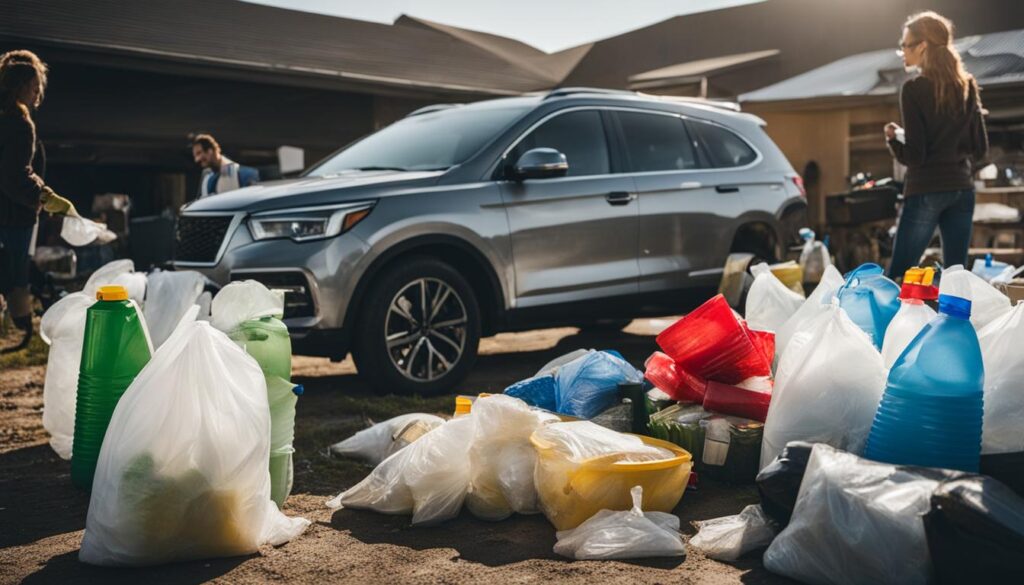
| Serving and Clean up Tips |
|---|
| Separate raw and cooked foods on separate plates and utensils. |
| Use long-handled serving spoons and tongs to minimize bare hand contact. |
| Opt for disposable plates, cups, and silverware to prevent cross-contamination. |
| Dispose of leftover perishable foods that have been in the temperature danger zone for more than 2 hours. |
| Clean and sanitize all surfaces, utensils, and serving dishes after the tailgate. |
| Store leftover food in sealed containers in a refrigerator or cooler. |
Planning Ahead for Tailgating
Thorough planning is key to a successful and safe tailgate event. By carefully preparing and organizing your menu, you can ensure that all food safety practices are followed and that your guests enjoy a delicious and risk-free experience.
Make a Checklist
Start by creating a checklist of all the foods and beverages you plan to serve at your tailgate. Consider the number of guests and the duration of the event to estimate the quantities needed. This will help you avoid last-minute trips to the store or rushed food preparation, reducing the risk of overlooking important food safety guidelines.
Menu Preparation
When planning your menu, choose foods that are easy to transport, cook, and serve outdoors. Opt for dishes that can be prepared in advance and require minimal on-site preparation. This will allow you to focus on maintaining food safety practices instead of spending too much time handling food at the tailgate site. Consider incorporating a variety of options to cater to different dietary preferences and restrictions.
Food Safety Tips
- Store raw meats, poultry, and seafood separately from ready-to-eat foods in coolers to avoid cross-contamination.
- Use ice packs or frozen water bottles to keep perishable foods at a safe temperature of 40°F or below during transportation.
- Bring a food thermometer to ensure that all cooked meats reach the proper internal temperature. Refer to the USDA guidelines for safe minimum temperatures.
- Pack disposable gloves for handling raw meats and other potential sources of contamination.
- Provide handwashing stations or hand sanitizers for guests to maintain good hygiene.
By planning ahead and following these food safety tips, you can enjoy a worry-free tailgate event, knowing that you have taken all the necessary precautions to ensure the safety of your guests.
| Planning Ahead for Tailgating |
|---|
| Make a Checklist |
| Menu Preparation |
| Food Safety Tips |
Temperature Control for Food Safety
Maintaining proper temperature control is crucial for food safety during tailgating. It is important to keep perishable foods at the right temperature to prevent the growth of harmful bacteria. Here are some tips to ensure temperature control and keep your food safe:
Invest in a Reliable Cooler
A reliable cooler is essential for keeping your perishable foods at a safe temperature. Look for a cooler that is well-insulated and can maintain low temperatures for an extended period. Consider investing in a cooler that is specifically designed for outdoor activities like tailgating.
Use Plenty of Ice or Ice Packs
Fill your cooler with plenty of ice or ice packs to create a cold environment for your perishable foods. It is important to ensure that the cooler is filled to capacity to maintain the desired temperature. Avoid overpacking the cooler, as this can reduce the effectiveness of the insulation.
Monitor Temperatures with a Food Thermometer
Using a food thermometer is an easy way to monitor the temperature of your food. Check the temperature of any perishable items such as meat, poultry, or seafood to ensure they are stored below 40°F. This will help prevent the growth of bacteria that can cause foodborne illnesses.
Remember to pack a food thermometer in your tailgating essentials to easily check the temperature of your cooked food as well. It is important to cook food, especially meat, to the recommended internal temperature to ensure it is safe to eat.
By following these temperature control practices and using a food thermometer, you can ensure that the food at your tailgate remains safe and enjoyable for everyone. Keeping your food at the appropriate temperature is a simple yet effective way to prevent foodborne illnesses and ensure a successful tailgating experience.
Safe Food Handling Practices
Proper food handling is crucial to ensure the safety of your tailgate event and prevent cross-contamination and the spread of foodborne illnesses. By following these food safety practices, you can enjoy delicious food without compromising your health or that of your guests.
1. Wash Your Hands
Before and after handling food, make sure to wash your hands thoroughly with soap and water for at least 20 seconds. This simple step helps remove harmful bacteria and reduces the risk of contamination.
2. Use Separate Cutting Boards
To avoid cross-contamination between raw meats and ready-to-eat foods, it’s important to use separate cutting boards. Use one board for raw meats and another for fruits, vegetables, and other ready-to-eat items.
3. Cook Meat to the Recommended Temperature
Properly cooking meat is essential to kill any bacteria and ensure its safety. Use a food thermometer to check the internal temperature of meat, and make sure it reaches the recommended temperature. Here are some examples:
| Meat | Safe Minimum Internal Temperature |
|---|---|
| Poultry (including ground poultry) | 165°F (74°C) |
| Ground meats (excluding poultry) | 160°F (71°C) |
| Pork, veal, and lamb | 145°F (63°C) |
4. Avoid Cross-Contamination
Keep raw meats separate from other foods to prevent cross-contamination. Store them in separate containers and use separate utensils for handling them. This will help reduce the risk of bacteria spreading from raw meats to other items.
5. Store Leftovers Safely
After the tailgate, properly store any leftovers to maintain their safety. Refrigerate perishable foods within two hours to prevent bacteria growth. If the temperature is above 90°F (32°C), refrigerate within one hour. Use shallow containers to cool and store leftovers.
By following these safe food handling practices, you can minimize the risk of foodborne illnesses and ensure that your tailgate event is a safe and enjoyable experience for everyone.
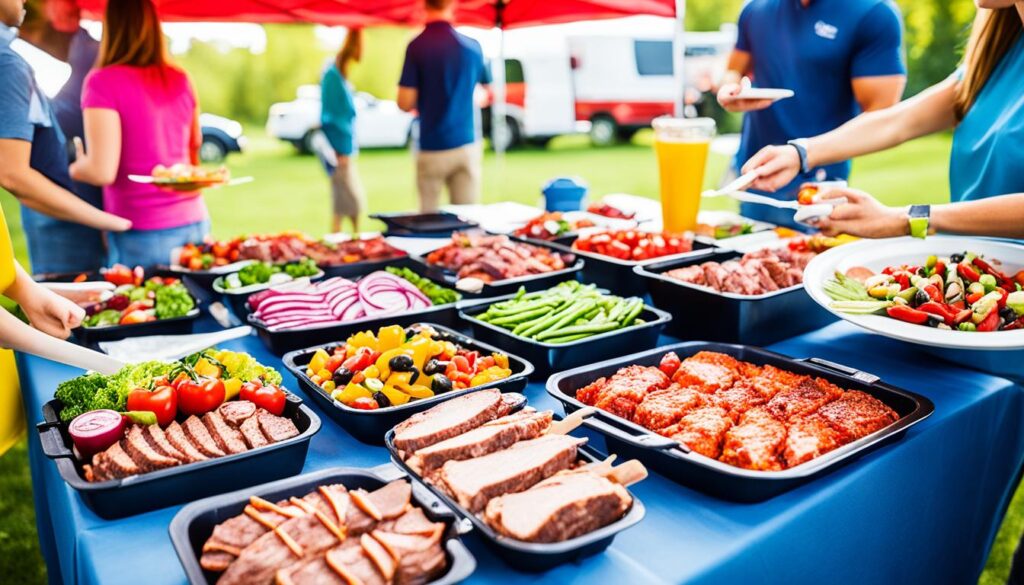
Hygiene and Labeling
Ensuring good hygiene practices is essential for maintaining food safety at tailgate events. By providing hand sanitizers and disposable wipes, you can help prevent the spread of bacteria among your guests. Encourage everyone to use these hygiene products before handling food to minimize the risk of contamination.
Another important aspect of food safety is allergen labeling. Many people have allergies or dietary restrictions, and labeling dishes to indicate common allergens like peanuts, gluten, or dairy can help guests make informed choices and avoid potential health risks. Consider using small signs or tent cards to clearly display allergen information for each dish.
“By prioritizing hygiene and labeling, you enhance food safety and create a more inclusive environment for all attendees.”
Remember, proper food handling practices are crucial for the safety and well-being of everyone at your tailgate. Implementing good hygiene practices and providing clear allergen labeling can go a long way in preventing foodborne illnesses and ensuring a successful and enjoyable event for all.
Conclusion
Prioritizing food handling safety is crucial for a successful and enjoyable tailgate event. By following proper food safety practices, such as maintaining proper temperatures, practicing good hygiene, and handling food safely, you can ensure that your tailgate is a hit without any hitch of foodborne illnesses.
Remember to keep cold foods cold and hot foods hot, using insulated coolers and thermos containers. Wash your hands thoroughly and frequently with soap and water to prevent the spread of bacteria. When grilling, use a calibrated food thermometer to determine the proper cooking temperature.
Proper serving practices, such as using separate plates for raw and cooked foods, can help prevent cross-contamination. And don’t forget to clean up properly after the tailgate to maintain food safety and hygiene. By following these food safety guidelines, you can ensure a safe and enjoyable tailgating experience for yourself and your guests. Enjoy your next tailgate knowing that you have prioritized food handling safety.
Source Links
- https://extension.umn.edu/preserving-and-preparing/tailgating-food-safety
- https://agrilifetoday.tamu.edu/2023/09/13/tailgate-food-safety-before-during-and-after-a-game/
- https://ucanr.edu/blogs/blogcore/postdetail.cfm?postnum=57820

Ryan Conlon is a passionate football fan and the driving force behind “Home Tailgate Party.” Ryan’s love for the game, combined with his culinary expertise, has led to a treasure trove of game day recipes and strategies. Whether you’re a seasoned tailgating pro or a rookie looking to up your game, Ryan’s insights and delicious recipes will help you score big at your next tailgate.

